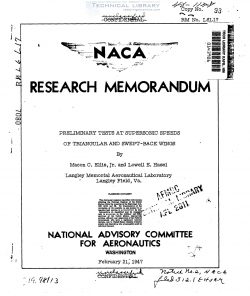naca-rm-l6l17
- Version
- 144 Downloads
- 1.21 MB File Size
- 1 File Count
- March 14, 2017 Create Date
- March 14, 2017 Last Updated
National Advisory Committee for Aeronautics, Research Memorandum - Preliminary Tests at Supersonic Speeds of Triangular and Sweptback Wings

A series of thin, triangular plan-form wings has been tested
in the model supersonic tunnel at Langley. The series consisted of
eight triangular wings of vertex angles such that a range of leading-
edge positions both inside and outside the Mach cone at the two test
Mach numbers of 1.143 and 1.71 was obtained. Three swept-back wings
having angles of sweep of 150, 55°, 'and 63° were also tested at a
Mach number of 143. These swept-back wings had circular-arc sections
with rounded leading edges and thiclmesses of 13.3 percent of the
chord measured normal to the leading edge. For each angle of sweep,
wings having two values of aspect ratio were tested.
Lift results for the triangular wings indicated that Jones'
theory for the lift of slender pointed wings is applicable for thin
wings in the range of test Mach numbers up to values of tan 6 equal to
approximately 0.3, where a is the wing vertex half-angle and m is
the Mach angle. The center of pressure of the triangular wings was
coincident with the center of area for all the wings tested at both
Mach numbers. The lowest minimum drag coefficients were obtained
for the wings with smallest vertex angles relative to the Mach angle.
A150 in this smallest vertex-angle region, the highest values of
maximum L/D of about seven for both Mach numbers were obtained.
It was thus indicated from the tests that wings having triangular
plan forms should be operated well within the Mach cone for maximum
efficiency.
Results of the swept-back-wing tests compared with triangular
wing results for a Mach number of lJ+3 show the same trends of lift
and drag as the sweep angle is changed. For corresponding sweep
angles, the swept-wing lift— curve slopes were lower than those for
triangular wings, due probably to the increased thickness. It is
indicated from the tee Us that for a- Mach number of l 11-, the angle of
sweep must be increased. to about 60° to obtain low drag coefficients
of the same magnitude as those due to skin friction '
Recent theories of low—aSpect—ratio triangular wings and swept
wings by Jones (references 1 and 2) have indicated the advantages
to be gained th1ough the use of pointed plan~fom wings for high-
speed flight. Numerous tests both in this country End in Germany
have shown that the drag rise with Mach number just below sonic
velocity usually associated with wings having their leading edges
normal to the flight direction may be delayed to higher speeds by
the use of sweepback.
| File | Action |
|---|---|
| naca-rm-l6l17 Preliminary Tests at Supersonic Speeds of Triangular and Sweptback Wings.pdf | Download |

Comment On This Post